5. Work in groups. Each student chooses one activity from 4. Take turns to say them aloud. The group says which country he/ she is talking about.
(Làm việc theo nhóm. Mỗi học sinh chọn 1 hoạt động từ bài 4. Lần lượt nói to chúng lên. Cả nhóm nói bạn đó đang nói về quốc gia nào.)
Example: (Ví dụ: )
- They throw water on other people.
(Họ ném nước vào người khác.)
- It's Thailand.
(Đó là Thái Lan.)
A: They put 12 grapes in the mouth. (Họ cho 12 quả nho vào miệng.)
B: It’s Spain. (Đó là Tây Ban Nha.)
A: They ring bells 108 times. (Họ rung chuông 108 lần.)
B: It’s Japan. (Đó là Nhật Bản.)
A: They throw coins into a river. (Họ ném đồng xu xuống sông.)
B: It’s Romania. (Đó là Romania.)
A: They drop ice cream on the floor. (Họ làm rơi kem xuống sàn.)
B: It’s Switzerland. (Đó là Thụy Sĩ.)

Các bài tập cùng chuyên đề
Happy New Year!
(Chúc mừng năm mới!)
1. Listen and repeat.
(Nghe và lặp lại.)
Linda: Phong, does Viet Nam celebrate New Years?
Phong: Yes, we do. We have Tet.
Linda: When is Tet?
Phong: At different times. This year, it's in January
Linda: What do you do at Tet?
Phong: We clean our homes and decorate them with flowers.
Linda: Is Tet a time for family gatherings?
Phong: Yes. It's a happy time for everybody.
Linda: Great.
Phong: Yes, and another good thing about Tet is that children get lucky money.
Linda: That sounds interesting. Is there anything special people should do?
Phong: We should say "Happy New Year" when we meet people, and we shouldn't break anything.
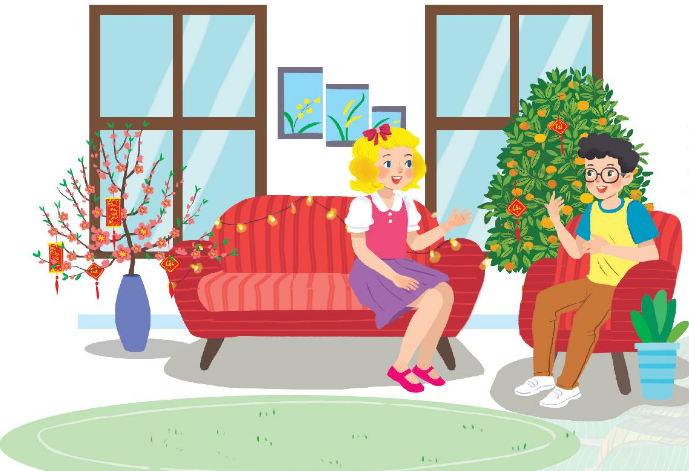
2. What are Phong and Linda talking about?
(Phong và Linda đang nói về cái gì?)
A. New year in the world
(Năm mới trên thế giới)
B. Tet in Viet Nam
(Tết ở Việt Nam)
C. What to eat and wear during Tet
(Nên ăn gì và mặc gì vào ngày Tết)
3. Complete the sentences about Tet with the information from the conversation in 1.
(Hoàn thành các câu về tết với thông tin từ bài hội thoại ở hoạt động 1.)
1. This year Tet is in____________.
2. We decorate our____________.
3. Tet is a time for family____________.
4. Children get____________ ____________.
5. People shouldn’t ____________ anything.
New Year practices in the world
(Các tập tục trong Năm mới trên thế giới)
3. QUIZ: Match the sentences with the pictures. Then match them with the countries.
(Câu đố: Nối các câu với ảnh tương ứng. Sau đó nối chúng với quốc gia tương ứng.)
1. They go to Times Square to watch the New Year's Eve Ball drop.
(Họ đến Quảng trường Thời đại để xem Vũ hội đêm giao thừa.)
2. They bathe in an ice hole.
(Họ tắm trong một hố băng.)
3. They eat mochi rice cakes.
(Họ ăn bánh gạo mochi.)
4. They throw water on other people.
(Họ tạt nước vào người khác.)
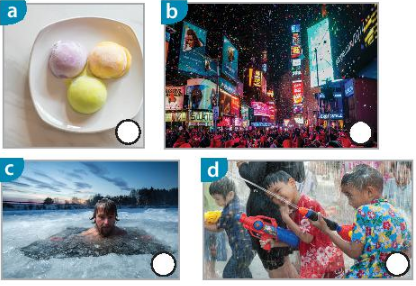
| Thailand Japan The USA Russia |
4. Read how people in different countries celebrate their New Years. Then match the countries with the activities.
(Đọc về cách mọi người ở những quốc gia khác nhau tổ chức năm mới. Sau đó nối các quốc gia với các hoạt động.)
In Japan, temples ring their bells 108 times at midnight on December 31. By doing so, people believe the bad things of the past year will leave.
In Spain, people try to put 12 grapes in their mouth at midnight for good luck.
In Switzerland, they drop ice cream on the floor to celebrate the New Year.
In Romania, they throw coins into a river for good luck.
In Thailand, they throw water on other people to wash away bad luck.
|
Countries |
Activities |
|
1. Japan 2. Spain 3. Switzerland 4. Romania 5. Thailand |
a. put 12 grapes in the mouth b. ring bells 108 times c. throw coins into a river d. throw water on other people e. drop ice cream on the floor |
Reading
1. Reading the passages and decide who says sentences 1-5.
(Đọc các đoạn văn và quyết định ai nói các câu 1-5.)
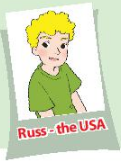
I often go to Times Square with my parents to welcome the New Year. When the clock strikes midnight, colourful fireworks light up the sky. Everybody cheers and sings.
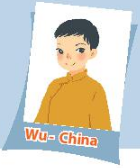
On New Year's Day, we dress beautifully and go to our grandparents' houses. We wish them Happy New Year and they give us lucky money. Then we go out and have a day full of fun.
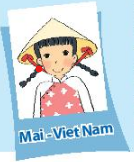
I learn some customs about Tet from my parents. People give rice to wish for enough food and buy salt to wish for good luck. Dogs are lucky animals but cats are not. A cat's cry sounds like "poor" in Vietnamese.
| A. Russ B. Wu C. Mai |
|
Statements |
Who |
|
1. Dogs are lucky animals. 2. We welcome the New Year at Times Square. 3. Children get lucky money. 4. We give rice to wish for enough food. 5. Children dress beautifully. |
C |
2. Test your memmory!
Tick (✓) the things which appear in the passages and cross (x) the ones which don't.
(Kiểm tra khả năng nhớ của em! Đánh dấu (✓) sự việc xuất hiện trong bài đọc và đánh dấu (x) cho sự việc không xuất hiện trong bài đọc.)
|
a. lucky money |
|
b. a day full of fun |
|
|
c. a cat's cry |
|
d. decorating the house |
|
|
e. fireworks |
|
f. saying wishes |
|
|
g. cheering and singing |
|
h. visiting relatives |
|
1. Match the New Year activities with the countries in the box. Make a guess if you don’t know.
(Ghép các hoạt động năm mới với các quốc gia trong hộp. Hãy đoán nếu bạn không biết.)
|
Scotland the USA Chile Denmark Thailand Korea |
In which country do people ….?
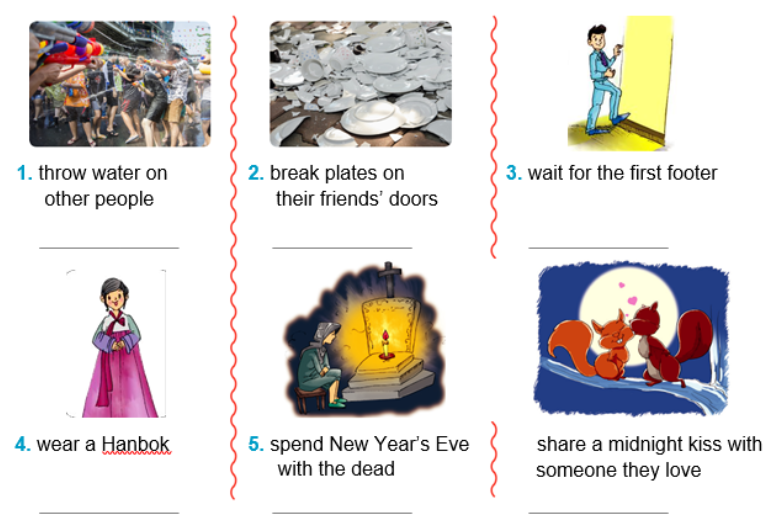
2. Read about strange New Year’s practices in some countries. Then tick T (True) or F (False).
(Đọc về các phong tục đón năm mới kỳ lạ ở một số quốc gia. Sau đó đánh dấu vào T (Đúng) hoặc F (Sai).)
|
Denmark – Some people have a loud way of celebrating the New Year. They throw plates on their friends’ doors. The people with many dishes outside their doors feel proud because they have a lot of friends. The USA – It’s a tradition in America to share a midnight kiss with someone you love. This will make the coming year beautiful and full of love for you. Chile – In Chile people participate in a mass on New Year’s Eve. Then they go to the graveyard, sit on their chairs and wait for the New Year with the dead. Korea – On New Year’s days, children wear a Hanbok, a traditional Korean dress, make one bow to their elders and wish them a long and healthy life. In return, they receive advice and some money. |
|
T |
F |
|
|
1. The Americans exchange a midnight kiss with someone they love. |
||
|
2. Korean elders bow to their children. |
||
|
3. In Chile, people welcome the New Year with the dead. |
||
|
4. Korean children make three bows to their elders. |
||
|
5. In Denmark, people celebrate the New Year quietly. |
3. Read the passages again and complete the sentences with the words / phrases given in the box.
(Đọc lại các đoạn văn và hoàn thành các câu với các từ / cụm từ cho sẵn trong hộp.)
|
midnight kiss children Chileans break Hanbok |
1. The ______________ go to the graveyard on New Year’s Eve.
2. A ______________ will bring a New Year full of love.
3. The Danish ______________ plates on their friends’ doors at the New Year.
4. Korean children wear a ______________ at the New Year.
5. The Korean elders give their ______________ advice and some money.
2. Fill each blank with one suitable word from the box to complete the passage below.
(Điền vào mỗi chỗ trống bằng một từ thích hợp từ ô trống để hoàn thành đoạn văn dưới đây.)
|
at wish will festivals rarely if from last dress until |
New Year is one of the four important traditional (1)______ in the United States. On New Year's Eve, most people go to parties. At twelve o'clock (2)______ night, everyone says "Happy NewYear!" and they (3) ______their friends and relatives good luck. New Year's parties usually (4) ______a long time. Some people don't go home (5) ______morning. Another holiday, Halloween, is mainly for children. On this holiday children (6) ______as witches, ghosts or other characters. Most of the children go (7)______ house to house and say 'Trick or Treat". (8)______ the people at the house do not give them candy, the children (9)______ play a trick on them. But this (10) ______happens. Most people give them candy or fruit.
Read the passage, choose the best answer.
Lunar New Year, or Tet, is Vietnam's main holiday. It is the most important occasion in the year which falls sometimes between 19th january and 20th February on the Western calendar. Tet marks the beginning of spring and the start of a new year.
Tet’s preparations and celebrations nowadays are shorter than those in the past. Streets are decorated with coloured lights and red banners. Shops are full of goods. People are busy buying gifts, cleaning and decorating their houses and cooking traditional foods.
Houses are often decorated with plants and flowers at this time. Peach blossom is traditional at Tet in the North while apricot blossom is traditional in the South. The kumquat tree with its ripe deep orange fruits is popular throughout the country. One of Tet’s most special foods is Banh Chung, which is made from sticky rice, green beans and fatty pork. Mut, which is candied fruits such as sugared apples, plums or tomatoes, is also popular.
* Một số từ mới:
- mark (v): đánh dấu
- preparation (n): sự chuẩn bị
- ripe deep orange fruits: quả chín vàng rộm
- plum (n): quả mận
Read the passage carefully and choose the correct answer.
Every country has its own tradition when New Year comes. In Japan, at midnight on December 31, all temples in the country ring their bell 108 times. They believe that the ringing bells can remove their bad actions from the previous year.
In Thai Lan, the New Year is in April. It’s the hottest time of the year. People often throw water over the people. They believe that this activity will bring a lot of rain and wash away the bad things.
In Viet Nam, people clean and decorate their houses before Tet. They would like their houses to look more beautiful. The first footer is very important. They believe that the first footer on the first New Year Day decides the family’s luck for the whole year.
Một số từ vựng:
- tradition (n): truyền thống
- ring the bell: rung chuông
- wash away: rửa sạch, cuốn trôi
- luck (n): điều may mắn
Choose true or false.
Linh and her friends went camping for four days in Da Lat. They left their house at 6 o'clock. Ha brought a tent and some foods. Tom brought a ball to play volleyball. Ly brought her camera to take some photos. Nga and Mai brought some drinks. They took some orange juice. They didn't take iced tea because it was cold. They also took some food. Their favorite foods are chicken, lettuces and tomatoes. Ha's mother helped them to arrange food and drink for their camping. They stayed in a small hotel. The hotel looked over a very beautiful garden with a lot of flowers and green trees. They enjoyed the fresh air there. Linh said her dream house was one surrounded by a flower fence.
Read the following dairy entry. Choose the correct answer for each blank.
📔 My Tet Holiday – Diary Entry
Monday, February 12th
Today is the last day of Tet holiday. I had a great time (1) ______ my family!
Before Tet, we cleaned the house and (2) _______ it with flowers. My mom cooked a lot of food like banh chung and spring rolls. Everything was so tasty!
On the first day of Tet, I wore new clothes and got (3) _______ money from my parents and grandparents. We visited relatives and said “Chúc Mừng Năm Mới!”
I played games with my cousins and watched lion dances on TV. We also went to the pagoda to pray for (4) ______ good year.
I feel happy and lucky. Tet is my favorite holiday. I want it to last longer!
Read the passage, then tick true (T) or false (F) for the following statements.
Dear Peter,
Thank you for your letter. It’s very interesting to know about schools in the USA.
I think schools in Vietnam are a little different. Vietnamese students usually wear school uniform when they are at school. Classes start at 7.00 each morning and end at 11.15. Students have a 30-minute break after three periods. At break, many students play games. Some go to the canteen and buy something to eat or drink. Others talk together. Our school year lasts for nine months, from September to May. Then we have a three-month summer vacation.
Please write soon and tell me about your summer vacation.
Your friend,
Hoa
* Một số từ mới:
- different (adj): khác biệt
- uniform (n): đồng phục
- period (n): tiết học
- summer vacation: kì nghỉ hè
1. Schools in Viet Nam are the same as schools in the USA.
2. There is no school uniform in Viet Nam.
3. Classes last from seven to a quarter past eleven a.m.
4. Students have a break after the second period.
5. The school year begins in September.
6. Summer vacation lasts for three months.
Choose the best answer to complete the sentences.
In our country, Vietnamese New Year (Tet holiday) is according to "lunar calendar", not "solar calendar". "Vietnamese New Year" is a very important holiday for Vietnamese people. Everyone will (1) _____ a break during the Vietnamese New Year. It is a time for rest and refreshment. Most of the business, stores, even the schools close (2) _________ a time.
On the "New Year's Eve", each family will have "reunion dinner" with their family members. After the dinner, elders (parents, uncles, aunts, grandparents...etc) will give the "red envelope" (3) ________ the kids. There is "lucky money in the red envelopes.
We set off the "fireworks" and "firecrackers" during the Tet holiday. We also will hang the "Spring Couplet" on our doors. Some of the people are play "dragon dance" or "lion dance" to (4) __________ the Vietnamese New Year. Tet is the (5) ____________ festival in Vietnam.






